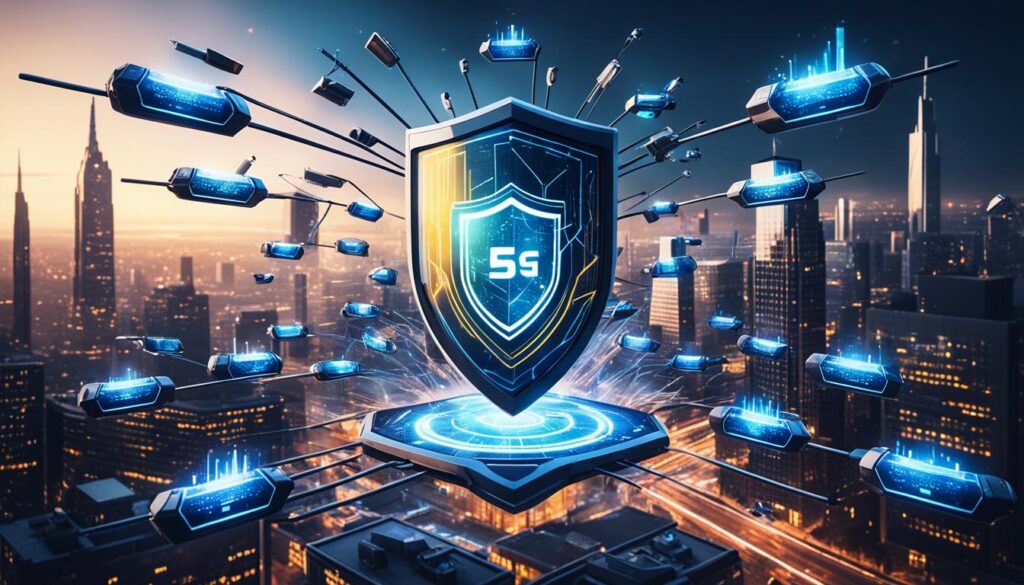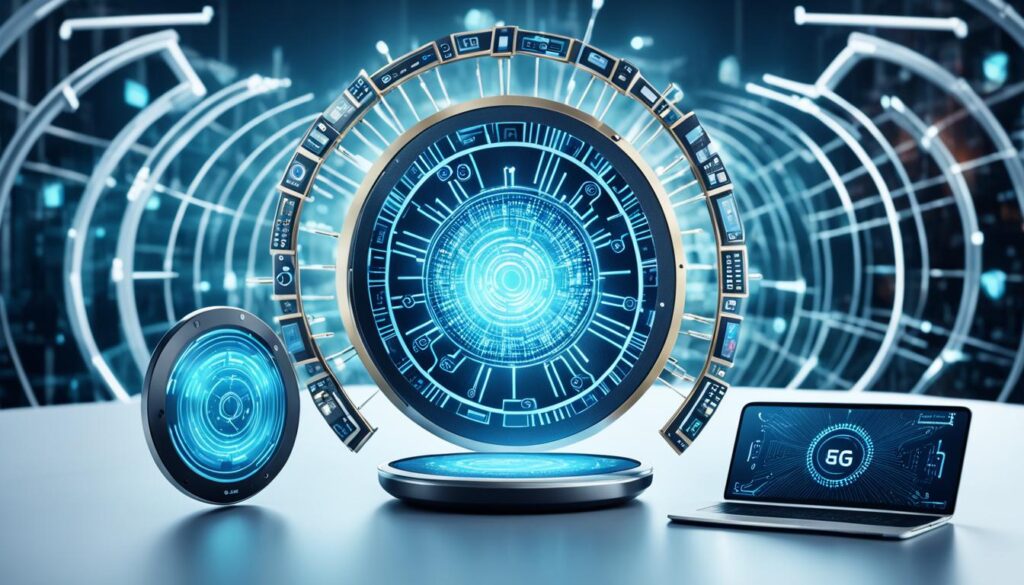With the advent of 5G technology, the world is experiencing a new era of connectivity. This fifth generation of mobile phone wireless networks brings higher speeds, lower latency, and more reliable performance. By 2025, it is estimated that there will be over 3.5 billion 5G connections globally. While the benefits of 5G are undeniable, it is essential to recognize the cybersecurity challenges that come with this revolutionary technology.
In the 5G era, cyber threats are becoming more sophisticated and pervasive. The adoption of 5G without proper security measures can expose individuals, businesses, and governments to significant risks. The transition from 4G to 5G is unlike any previous network generation. It is expected to have a massive impact on critical infrastructure, introduce new functionalities and capabilities, and increase the attack surface for cybercriminals.
To safeguard your devices and network in the 5G era, it is crucial to implement robust security measures and best practices. This includes securing IoT devices in the 5G network, as the integration of these devices expands the potential attack surface. Additionally, network security best practices, such as encryption, authentication, and continuous monitoring, are essential to mitigate the cybersecurity challenges of 5G technology. By staying vigilant and proactive, you can shield your devices and network from vulnerabilities in the evolving 5G landscape.
Key Takeaways:
- The impact of 5G on cybersecurity requires robust security measures and best practices.
- Securing IoT devices in the 5G network is crucial to mitigate cyber threats in the 5G era.
- Implementing encryption, authentication, and continuous monitoring is essential for network security in the 5G landscape.
- The transition to 5G introduces new cybersecurity challenges, including software vulnerability and increased attack surface.
- Stay proactive and vigilant to protect your devices and network in the evolving world of 5G.
The 5G Network vs. Previous Generations
In the evolution of mobile network technology, each generation has brought significant advancements in terms of capabilities and speeds. From 1G to 4G, we have witnessed remarkable progress in wireless connectivity. However, with the advent of 5G, we are now entering a new era of mobile communication with revolutionary features and functionalities.
1G, 2G, 3G, and 4G have paved the way for 5G, but it is important to understand how the fifth-generation network sets itself apart. Unlike its predecessors, 5G represents enhanced mobile broadband with higher connectivity, lower latency, and faster download speeds. It promises to deliver a transformative experience for users, making real-time applications such as augmented reality (AR), virtual reality (VR), and autonomous vehicles a reality.
The transition to 5G involves a complete overhaul of traditional network architecture to accommodate the demands of this new technology. From radio access networks (RAN) to core networks, 5G architecture introduces new concepts such as network functions virtualization (NFV) and software-defined networking (SDN) to support services and technologies that were not possible with previous generations.
Let’s take a closer look at the features that distinguish 5G from its predecessors:
Higher Connectivity: 5G offers significantly higher connectivity, enabling more devices to connect simultaneously while providing stable and seamless network experiences.
Lower Latency: Latency refers to the time it takes for data to travel between devices. With 5G, latency is reduced to near-instantaneous levels, allowing for real-time and mission-critical applications.
Faster Download Speeds: 5G networks are designed to deliver blazing-fast download speeds, allowing users to download large files, stream high-quality videos, and access data-intensive applications with ease.
With these new features, 5G networks are set to revolutionize industries and transform the way we live, work, and communicate. The image below provides a visual representation of the significant improvements 5G offers compared to previous generations:

5G Cybersecurity Challenges
As 5G technology continues to evolve and gain widespread availability, it brings about new cybersecurity challenges that need to be addressed. The software-based nature of 5G networks and their increased connectivity create unique vulnerabilities that hackers can exploit. Let’s explore some of the key challenges:
Software Vulnerability:
One of the major cybersecurity challenges in 5G networks is the presence of software vulnerabilities. Hackers can exploit these vulnerabilities to gain unauthorized access and control, putting sensitive data at risk.
IoT Integration and Connectivity:
The integration of Internet of Things (IoT) devices in 5G networks expands the attack surface, posing security risks. Weak security measures in IoT devices can be exploited by malicious actors, compromising the overall network security.
Lack of Built-in Security:
Many IoT devices lack built-in security features, making them susceptible to cyberattacks. The absence of robust security protocols leaves these devices vulnerable to unauthorized access and data breaches.
Data Protection Issues:
Data protection is a critical concern in 5G networks. With the increased transfer of vast amounts of data, ensuring its privacy and integrity becomes more challenging. Data breaches can lead to severe consequences for both individuals and organizations.
DDoS Potential:
5G networks’ enhanced bandwidth and widespread availability create an environment that is susceptible to Distributed Denial of Service (DDoS) attacks. The high-speed connectivity and increased number of devices connected to 5G networks can amplify the impact of such attacks.

5G Security Architecture
In the era of 5G, security architecture plays a crucial role in safeguarding networks and protecting sensitive data. The 5G core network is designed around a service-based architecture (SBA), which leverages cloud-based technologies to ensure authentication, security, and session management.
The use of network functions virtualization (NFV) in 5G allows for the virtualization of network services. This enables the implementation of customized security controls and enhances data protection. By virtualizing network functions, 5G can provide flexible and scalable security solutions tailored to specific use cases.
One of the key features of 5G security architecture is stronger encryption. With 256-bit cryptographic algorithms, data transmitted through 5G networks is well-protected against unauthorized access. This encryption ensures the confidentiality and integrity of sensitive information.
5G also prioritizes data privacy, addressing one of the major concerns of the previous network generations. By implementing robust privacy protocols, 5G networks protect user data and prevent unauthorized tracking and monitoring.
Authentication and authorization protocols are essential components of 5G security architecture. These protocols verify the identity of users, devices, and network elements, ensuring only authorized entities can access the network. This multi-layered authentication process strengthens the overall security of 5G networks.
In the context of roaming, 5G provides end-to-end security protection for source and destination network traffic. This roaming security ensures that data exchanges between different networks are secure and protected, regardless of the location.
To enhance reliability and mitigate potential incidents, 5G introduces network slicing. This feature allows for the customization of security controls for specific use cases. By creating dedicated slices within the network, 5G can ensure the appropriate security measures are in place based on the specific requirements of different applications or industries.
5G Security Architecture Overview:
| Key Features | Description |
|---|---|
| Service-Based Architecture (SBA) | Relies on cloud-based technologies for authentication, security, and session management. |
| Network Functions Virtualization (NFV) | Virtualizes network services for customized security controls and enhanced data protection. |
| Stronger Encryption | Utilizes 256-bit cryptographic algorithms for robust data protection. |
| Data Privacy | Implements protocols to safeguard user data and prevent unauthorized tracking. |
| Authentication and Authorization | Ensures the identity verification of users, devices, and network elements. |
| Roaming Security | Provides end-to-end security protection for source and destination network traffic. |
| Network Slicing | Allows for customized security controls based on specific use cases. |

5G Security Features
In the era of rapid technological advancements, securing the 5G network is crucial for protecting sensitive data and ensuring the privacy of individuals and organizations. To address these concerns, 5G networks incorporate a range of security features that enhance encryption, authentication, privacy, roaming security, and reliability.
Strong Encryption for Robust Data Protection
One of the key advancements in 5G security is the implementation of stronger encryption algorithms. With 256-bit cryptographic algorithms, 5G networks provide an enhanced level of data protection, making it significantly harder for cybercriminals to intercept and decipher sensitive information. This ensures that data transmitted over 5G networks remains secure from unauthorized access or tampering.
Improved Privacy and Integrity Protection
Compared to previous generations, 5G networks offer improved privacy and integrity protection for data passing through the network. These enhanced security measures eliminate vulnerabilities that were present in earlier network technologies, providing added assurance that confidential information remains confidential and uncompromised.
Enhanced Authentication Protocols
5G networks employ robust authentication protocols to verify the identity of users, devices, and network elements. These protocols support various authentication methods, including biometrics and two-factor authentication, ensuring that only authorized entities can access the network. By implementing stringent authentication measures, 5G networks mitigate the risk of unauthorized access and protect against identity theft.
End-to-End Roaming Security
To ensure end-to-end security protection for source and destination network traffic, 5G networks prioritize roaming security. This is achieved by implementing robust security mechanisms that authenticate and encrypt data as it traverses different networks, ensuring that data remains protected regardless of the network it is being routed through. This level of roaming security guards against potential vulnerabilities and unauthorized access during data transmission.
Reliability through Network Slicing and Dynamic Spectrum Sharing
Network slicing and dynamic spectrum sharing are integral features of 5G networks that enhance reliability and responsiveness. Network slicing allows for the creation of dedicated virtual networks that can be customized to specific security requirements, ensuring that critical applications and services receive the necessary security controls. Dynamic spectrum sharing optimizes the utilization of available spectrum resources, enabling quick response to potential security incidents and effectively managing network congestion.
| 5G Security Features | Description |
|---|---|
| Strong Encryption | Implementing 256-bit cryptographic algorithms for robust data protection |
| Improved Privacy and Integrity Protection | Enhancing the protection of data privacy and integrity in 5G networks |
| Enhanced Authentication Protocols | Implementing stringent authentication measures to verify identity |
| End-to-End Roaming Security | Ensuring security protection for source and destination network traffic during roaming |
| Reliability through Network Slicing and Dynamic Spectrum Sharing | Optimizing network reliability and responsiveness through customized security controls and efficient spectrum allocation |
These security features collectively contribute to building a robust and secure foundation for the 5G network, instilling confidence in users and enabling the seamless and secure exchange of data, even in highly dynamic and interconnected environments.

5G Security Benefits
As the world embraces the era of 5G technology, it brings with it a multitude of security benefits that enhance the protection and resilience of network users. Let’s explore some of the key advantages that 5G networks offer:
- Frequent Authentication: 5G networks implement frequent authentication protocols that help verify and validate the identity of users, devices, and network elements. This ensures only authorized entities are granted access to the network, minimizing the risk of unauthorized access and enhancing overall security.
- Integrity Checks: With 5G, integrity checks are performed regularly to ensure the data being transmitted or received hasn’t been tampered with or modified. These integrity checks help safeguard against data manipulation, ensuring the integrity and accuracy of the information being exchanged.
- Smart Automation: Leveraging the high-speed data transfer capabilities of 5G networks, organizations can embrace smart automation technologies. From factories incorporating robotic systems to autonomous vehicles equipped with advanced sensors, 5G enables seamless connectivity and real-time communication, driving efficiency and productivity while maintaining robust security measures.
- Critical Infrastructure Monitoring: 5G networks enable precise and real-time monitoring of critical infrastructure. From power grids to transportation systems, 5G facilitates the seamless integration of sensors and monitoring devices, collecting and analyzing valuable data to proactively prevent potential disruptions or security breaches.
- Smart Cities: The advent of 5G technology opens up new possibilities for the development of smart cities. With its reliable and low-latency communication, 5G enables the deployment of intelligent infrastructure, enhancing public safety, energy management, and transportation systems. These advancements are underpinned by stringent security measures embedded in the design of 5G networks.
5G networks provide the foundation for a secure and interconnected future, transforming industries and societies through seamless connectivity and advanced security features.
To further illustrate the benefits of 5G security, below is a table summarizing these advantages:
| Security Benefit | Description |
|---|---|
| Frequent Authentication | Regular verification of user, device, and network identity to prevent unauthorized access. |
| Integrity Checks | Regular validation of data to detect and prevent tampering or modification. |
| Smart Automation | Utilization of high-speed data transfer for seamless integration of automation technologies. |
| Critical Infrastructure Monitoring | Real-time monitoring of vital infrastructure for proactive maintenance and security. |
| Smart Cities | Development of interconnected cities with enhanced safety, energy management, and transportation systems. |
With the combination of frequent authentication, integrity checks, smart automation, critical infrastructure monitoring, and smart cities, 5G networks provide a secure foundation for innovation and progress in the connected world.
5G Security Challenges
Deploying 5G networks comes with its fair share of challenges, ranging from deployment cost to complex infrastructure vulnerabilities. Understanding and addressing these challenges is crucial to ensuring the security and integrity of the 5G ecosystem.
Deployment Cost
Implementing 5G networks requires significant investment, as it involves deploying more transmitters and implementing heightened security measures. The costs associated with infrastructure upgrades and network expansion can add up, posing financial challenges for network operators.
Supply Chain Vulnerabilities
The global supply chain for 5G equipment introduces vulnerabilities that can be exploited by hackers. As devices and components are sourced from various vendors and manufacturers worldwide, ensuring the integrity and security of the supply chain becomes increasingly complex.
Downgrade Attacks
As 5G networks need to remain interoperable with previous generations, such as 3G and 4G, downgrade attacks become a potential threat. Hackers can exploit vulnerabilities in older network technologies to compromise the security and functionality of 5G networks.
Shortage of Security Practitioners
There is a shortage of security practitioners with expertise in 5G security. The demand for skilled professionals who understand the intricacies of securing 5G networks exceeds the current supply, making it difficult to implement robust security protocols and measures.
Complexity of 5G Infrastructure
5G infrastructure is highly complex, with millions of connected devices and an increased attack surface. The sheer scale and diversity of the 5G ecosystem pose new cybersecurity challenges, making it harder to detect and mitigate potential threats effectively.
“The evolving nature of 5G technology requires a multi-faceted approach to security that encompasses industry collaboration, robust risk management, and continuous innovation.” – John Johnson, Chief Security Officer at XYZ Telecom
Despite the challenges, it’s essential to address these security concerns proactively to safeguard the 5G ecosystem from potential breaches and disruptions.
Stay tuned for the conclusion of our article, where we discuss the importance of 5G cybersecurity and the need for comprehensive security measures to mitigate these challenges.
Conclusion
Ensuring cybersecurity in the era of 5G is of utmost importance for the safety and security of individuals, businesses, and governments. With the widespread adoption of 5G technology, the need for comprehensive security measures has become critical.
Implementing encryption, authentication, and continuous monitoring are vital to protect networks and devices in the 5G era. These security measures help safeguard against cyber threats and ensure the integrity of data transmitted over 5G networks.
Ongoing evaluation of risks and vulnerabilities is essential as 5G technology continues to develop. As hackers become more sophisticated, it is crucial to stay one step ahead by identifying and addressing the evolving cybersecurity challenges that arise. By doing so, individuals, businesses, and governments can confidently embrace the benefits of 5G while mitigating potential risks.
FAQ
What is 5G?
5G is the 5th generation of mobile phone wireless network capability, offering higher speeds, lower latency, and more reliable performance.
How many 5G connections are expected globally by 2025?
It is expected that there will be over 3.5 billion 5G connections globally by 2025.
What are the cybersecurity risks with the adoption of 5G?
The adoption of 5G technology without proper cybersecurity measures can pose significant risks to governments, the public, and businesses.
How is 5G different from previous network generations?
The transition from 4G to 5G is unlike previous network generations, as 5G is expected to have a massive impact on critical infrastructure and offer new functionalities and capabilities.
What are the previous generations of mobile network technology?
Previous generations of mobile network technology include 1G, 2G, 3G, and 4G, each offering different capabilities and speeds.
What are the features of 5G networks?
5G represents enhanced mobile broadband with higher connectivity, lower latency, and faster download speeds.
What are the cybersecurity challenges of 5G technology?
5G technology introduces new cybersecurity challenges due to its software-based nature and increased connectivity.
How does the integration of IoT devices in 5G networks impact cybersecurity?
The integration of IoT devices in 5G networks expands the attack surface and poses security risks.
What are the security features of 5G networks?
5G security features include stronger encryption, better data privacy, authentication protocols, and end-to-end security protection for roaming.
How does 5G architecture enhance security?
Network slicing in 5G allows for customized security controls for specific use cases, improving reliability and mitigating potential incidents.
What are the benefits of 5G security?
5G networks provide frequent authentication and integrity checks, resulting in improved security for network users and enabling advancements in smart automation, critical infrastructure monitoring, and smart cities.
What are the challenges of ensuring cybersecurity in the era of 5G?
The complexity of 5G infrastructure, including millions of connected devices and increased attack surface, creates new cybersecurity challenges.
What is the importance of 5G cybersecurity?
Ensuring cybersecurity in the era of 5G is of utmost importance for the safety and security of individuals, businesses, and governments.
What are the recommended network security practices for 5G?
Comprehensive security measures, including encryption, authentication, and continuous monitoring, are necessary to protect networks and devices in the 5G era.
What actions should be taken to address evolving cybersecurity risks in 5G?
It is essential to evaluate and address evolving cybersecurity risks and vulnerabilities as 5G technology continues to develop.








